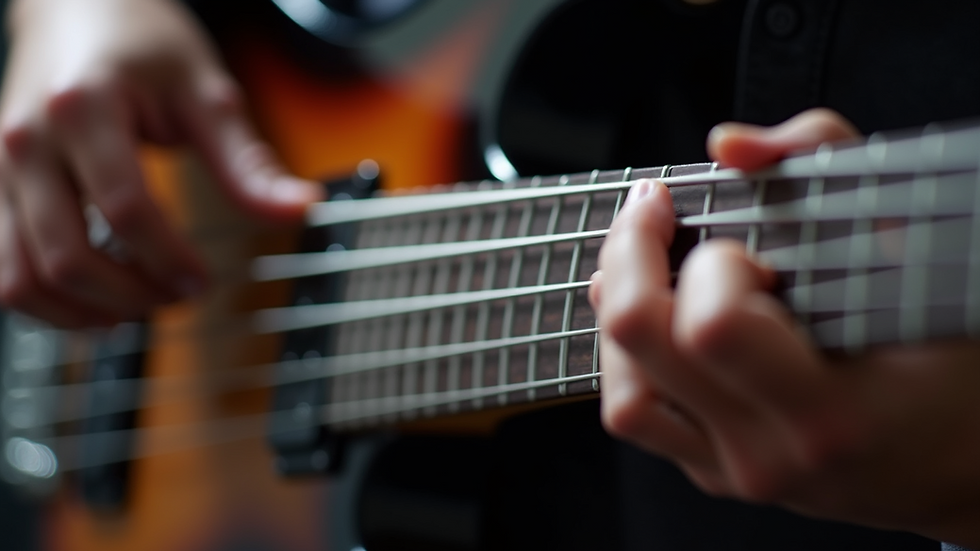Essential Bass Guitar Techniques for Every Player
- Simon

- 2 days ago
- 4 min read
Picking up the bass guitar is like stepping into the heartbeat of any band. Whether you’re just starting out or looking to sharpen your groove, mastering essential bass guitar skills is key to becoming a confident player. I’m here to walk you through some practical techniques and tips that will help you build a solid foundation and keep your playing fresh and exciting.
Let’s dive in and explore the world of bass guitar together. You’ll find this journey both fun and rewarding, with plenty of room to grow at your own pace.
Building Your Bass Guitar Skills: The Basics and Beyond
When I first started playing bass, I quickly realised that having a few core skills under your belt makes all the difference. These skills help you stay in time, lock in with the drummer, and create those deep grooves that get everyone moving.
Here are some fundamental bass guitar skills to focus on:
Finger positioning and plucking: Use your index and middle fingers to pluck the strings. Keep your hand relaxed and alternate fingers for a smooth, even sound.
Freting technique: Press the strings just behind the fret to avoid buzzing. Keep your fingers curved and close to the fretboard.
Timing and rhythm: Practice with a metronome to develop a strong sense of timing. The bass is the rhythmic anchor, so locking in with the beat is crucial.
Playing scales and arpeggios: These are the building blocks of bass lines. Start with major and minor scales, then explore arpeggios to add melodic interest.
Muting unwanted strings: Use your fretting hand’s palm or fingers to mute strings you’re not playing. This keeps your sound clean and tight.
Practising these basics regularly will set you up for success. Remember, consistency beats intensity. Even 10 minutes a day can lead to noticeable improvement.

How to Develop Your Bass Guitar Skills with Confidence
Confidence comes from knowing what you’re doing and feeling comfortable with your instrument. Here’s how you can build that confidence step by step:
Start slow: Don’t rush through songs or exercises. Play slowly and focus on accuracy.
Use backing tracks: Playing along with backing tracks helps you get used to real musical contexts.
Record yourself: Listening back to your playing reveals areas to improve and tracks your progress.
Learn songs you love: This keeps practice enjoyable and motivates you to push through challenges.
Experiment with tone: Try different finger placements, plucking positions, and amp settings to find your unique sound.
By approaching your practice with patience and curiosity, you’ll find that your bass guitar skills grow naturally. Plus, it’s a lot more fun when you’re enjoying the process!

What is the 3 Fret Rule on Bass?
If you’ve ever wondered how to navigate the fretboard efficiently, the 3 fret rule is a handy guideline. It suggests that when playing bass lines or scales, you should try to stay within a span of three frets at a time. This keeps your hand movement minimal and your playing smooth.
Here’s why it matters:
Reduces hand strain: Stretching too far can tire your hand quickly.
Improves speed and accuracy: Staying within three frets helps you move faster and hit notes cleanly.
Simplifies fingering: It’s easier to plan fingerings and transitions when you limit your range.
For example, if you’re playing a scale starting on the 3rd fret, try to play notes only up to the 5th or 6th fret before shifting your hand position. This approach makes complex passages more manageable.
Try practising simple scales using the 3 fret rule and notice how your hand feels more relaxed and your playing more fluid.

Exploring Advanced Techniques to Elevate Your Playing
Once you’re comfortable with the basics, it’s time to spice things up with some advanced techniques. These will add texture and personality to your playing:
Slap and pop: This funky technique involves slapping the string with your thumb and popping it with your fingers for a percussive sound.
Hammer-ons and pull-offs: These allow you to play notes smoothly without plucking every time, great for fast runs.
Slides: Sliding your finger up or down the fretboard adds expression and connects notes fluidly.
Ghost notes: Lightly muting the strings while plucking creates rhythmic, percussive sounds that add groove.
Tapping: Using your fingers to tap notes on the fretboard can create fast, intricate patterns.
Don’t worry if these sound tricky at first. Take them one at a time, and incorporate them slowly into your practice. Over time, they’ll become natural parts of your playing style.
If you want to explore these and other techniques in more detail, check out this excellent resource on bass guitar techniques.
Keeping Your Practice Fun and Effective
Practice doesn’t have to be a chore. Here are some tips to keep your sessions enjoyable and productive:
Set small goals: Focus on one skill or song section at a time.
Mix it up: Alternate between scales, songs, and technique exercises.
Jam with others: Playing with friends or online groups keeps things social and inspiring.
Use apps and tools: Metronomes, backing tracks, and tuner apps are great helpers.
Celebrate progress: Record your improvements and reward yourself for milestones.
Remember, every great bassist started where you are now. The key is to keep showing up and enjoying the journey.
Mastering essential bass guitar skills is a rewarding adventure. With patience, practice, and a bit of curiosity, you’ll find yourself creating grooves that move people and express your unique musical voice. Keep exploring, stay inspired, and most importantly - have fun with your bass!
Happy playing!




Comments